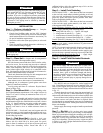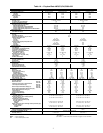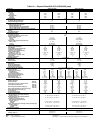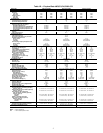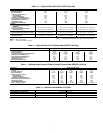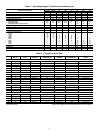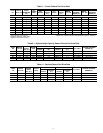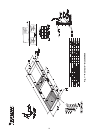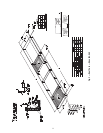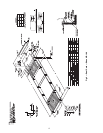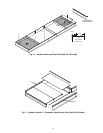
2
INSTALLATION
Step 1 — Perform Jobsite Survey —
Complete
the following checks before installation.
1. Consult local building codes and the NEC (National
Electrical Code) (ANSI/NFPA [American National Stan-
dards Institute/National Fire Protection Association] 70)
for special installation requirements.
2. Determine unit location (from project plans) or select unit
location.
3. Check for possible overhead obstructions which may in-
terfere with unit lifting or rigging.
Step 2 — Place Unit — Inspect unit for transportation
damage. File claim with transportation agency.
Provide clearance around and above unit for airflow, safety,
and service access. Do not restrict top (area above condenser
fans) in any way. Allow at least 6 ft on all sides for rated perfor-
mance, code compliance, and service. On units equipped with
power exhaust option, high velocity air is exhausted out the
hood. Unit should be positioned with at least 10 ft clearance be-
tween the exhaust hood and any obstruction.
Check unit dimensional drawings for unit arrangement and
minimum performance and service clearances.
Do not install unit in an indoor location. Do not locate air in-
lets near exhaust vents or other sources of contaminated air.
Although unit is weatherproof, guard against water from
higher level runoff and overhangs.
Level by using unit frame as a reference. Physical data is
shown in Tables 1A-9.
Step 3 — Roof Mount Unit — Check building codes
for weight distribution requirements. Unit weight is shown in
Tables 1A-1C and 5. Unit may be mounted on class A, B, or C
roofing material.
ROOF CURB — Assemble and install roof curb as described
in instructions shipped with the accessory. Accessory roof curb
and information required to field fabricate a roof curb is shown
in Fig. 1-5. Install insulation, cant strips, roofing and counter
flashing as required. For unit condensate drain to function
properly, curb must be level or within tolerances shown in
Fig. 1-5.
STEEL BEAMS — If roof curb is not used, support unit with
steel beams along its entire length and then support steel as re-
quired. As a minimum, unit must be supported across its width
at each lifting lug location.
Step 4 — Slab Mount Unit — Provide a level con-
crete slab that extends beyond unit cabinet at least 6 inches.
Make a slab 8 in. thick with 4 in. above grade. Use gravel
apron in front of condenser coil air inlet to prevent grass and
foliage from obstructing airflow. Ensure that slab is of
sufficient height to allow for condensate trap of 4 in. on sizes
030-070 or 7 in. on sizes 075-100.
Step 5 — Install Curb Gasketing
SIZE 030-060 UNITS — After ductwork has been connected
to the roof curb, attach adhesive-backed gasketing on all end
rails, cross rails, and duct rails. Be sure all joints and corners of
gasket are square and flush to prevent possible water leaks.
Follow all applicable building codes.
SIZE 070-100 UNITS — After ductwork has been connected
to the roof curb, apply gasket material (
1
/
2
-in. thick x 1
1
/
2
-in.
wide neoprene) where indicated.
Single-Thickness Gasketing (See Fig. 6-8 for Item Num-
bers) — Apply gasketing in the following places:
1. Along both side rails (1) — 2 places, full length
2. Along return air end rail (2) — 1 place
3. Around return air internal duct flange (3) — 1 or 2 places
4. Around supply air internal duct flanges (4) — 3 places
Double-Thickness Gasketing (See Fig. 6 and 8 and Detail
A-A) — Locate a line 9
3
/
4
-in. from the supply air end of the
accessory curb. Apply a double-thickness of gasket material
along line per detail A-A.
NOTE: Do not apply gasket material along the outside edge of
the curb (area “X”). This pan area of the curb extends out
beneath the end of the unit’s air handler section; applying gas-
ket here develops a potential water trap area on top of the curb.
Condenser Section Roof Curb (See Fig. 7)
— Apply single-
thickness gasket along both side rails (5).
Step 6 — Install Field-Fabricated Ductwork
The 48P2,P3 units are designed for vertical supply/return
only. Field-fabricated ductwork must be attached to the roof
curb, or to the support steel, prior to the final rigging and instal-
lation of the unit. Supply and return duct dimensions are shown
in Fig. 1-3.
To attach ductwork to roof curb, insert duct approximately 10
to 11 in. up into roof curb. Connect ductwork to 14-gage roof
curb material with sheet metal screws driven from inside the duct.
Secure all ducts to the building structure, using flexible duct
connectors between roof curbs and ducts as required. Ducts
passing through an unconditioned space must be insulated and
covered with a vapor barrier. Outlet grilles must not lie directly
below unit discharge.
Design supply duct strong enough to handle expected static
pressures.
Step 7 — Rig Unit — Do not drop unit; keep upright.
Use spreader bars over unit to prevent sling or cable damage.
Sheets of plywood placed along the condenser coils will pro-
vide additional protection. All lifting lugs MUST be used when
lifting unit. Level by using unit frame as a reference. See Fig. 9
and 10 for information. Unit and accessory weights are shown
in Tables 1A-1C and 5. Weight distribution and center of gravi-
ty can be found in Fig. 11.
CAUTION
Disconnect gas piping from units when leak testing at pres-
sures greater than 0.5 psig. Pressures greater than 0.5 psig
will cause gas valve damage resulting in a hazardous
condition. If gas valve is subjected to pressure greater than
0.5 psig, it must be replaced. When pressure testing field-
supplied gas piping at pressures of 0.5 psig or less, the unit
connected to such piping must be isolated by manually
closing the gas valve.
CAUTION
Do not lift unit with forklift truck. Move unit with over-
head rigging only.
WARNING
For vertical supply and return units, tools or parts could
drop into ductwork and cause an injury. Install a 90-degree
elbow in the supply and return ductwork between the unit
and the conditioned space. If a 90-degree elbow cannot be
installed, then a grille of sufficient strength and density
should be installed to prevent objects from falling into the
conditioned space. Failure to follow these instructions
could result in personal injury or property damage due to
falling objects.




